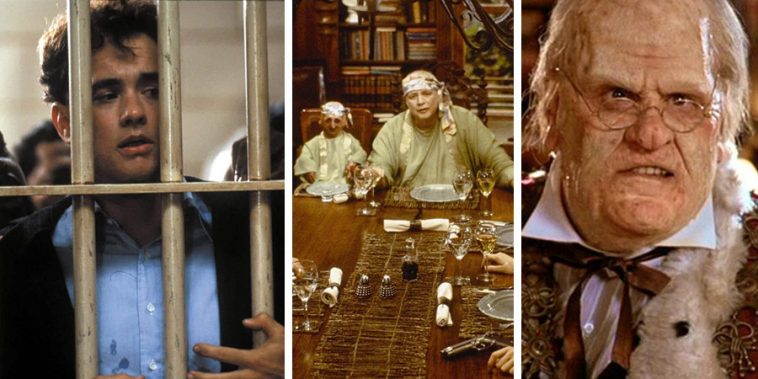Our series of 90s flops continues on with 5 of the more notorious disasters of the era:
Table of contents
1. The Bonfire of the Vanities (1990)
Warner Bros acquired the rights to Tom Wolfe’s best-selling controversial novel for $750,000 and tried to mount the picture with directors Adrian Lyne and Norman Jewison, but Bonfire never materialized with either. Brian De Palma was then signed to direct the high-profile project.
What should have been a modestly priced and very edgy satire, was envisioned by the studio and filmmakers as a big-budget and more commercial telling of the story – which required an A-list cast. The catastrophic miscasting of Tom Hanks and the newly bankable Bruce Willis got the movie greenlit with a $29 million budget. Then the overages began during production, to the point where executives began to demand that De Palma pay for scenes that cost more than $75,000. Costs on the film climbed to about $50 million.
De Palma had given journalist Julie Salamon complete access to the entire process of making The Bonfire of the Vanities – to show the pressure cooker environment a filmmaker has to go through to make a successful big-budget studio picture. Except Bonfire ended as a humiliating fiasco that she wrote into a book called The Devil’s Candy: The Anatomy Of A Hollywood Fiasco.
WB dated Bonfire as their major holiday end of the year release on December 22, 1990. WB and De Palma expected the movie to hit a cultural nerve and it was heavily marketed. As the release approached, there was nothing indicating just how off the mark the movie was and its commercial potential was still strong. Then the reviews posted, declaring Bonfire dead on arrival. A total stinker. One of the worst of the era. The most extreme kind of prestige trainwreck. Audiences got the message and stayed away. Bonfire of the Vanities pulled in just $15,691,192.
2. Nothing But Trouble (1991)
This bizarre monstrosity was Dan Aykroyd’s first and only detour into film directing. When asked about future directing efforts, Aykroyd said, “Nothing but Trouble came out when I was filming My Girl, and I remember knowing within about two days that it was all over.” “That movie set me back ten years. Nobody’s going to hand me the reins.”
Warner Bros financed Nothing But Trouble for just over $30 million and this was the first of a $23 million three-picture deal for Chevy Chase. After this disaster, the second project was the flop Memoirs of an Invisible Man (1992) and Vegas Vacation (1997) was the third movie.
Nothing But Trouble was originally dated for the 1990 Thanksgiving frame, but the release date was pushed back after reshoots were ordered following very negative test screenings. It was then scheduled as a major Christmas release and then moved to the dumping ground on February 15, 1991.
Knowing they have a complete turkey on their hands, WB did not screen the movie for critics, and knowing they had no idea how to market this oddity, it was dumped. The reviews that eventually posted were as bad as they come, audiences gave Nothing But Trouble a rare and hateful D+ Cinemascore and it quickly left theaters with only $8,479,793.
3. Jade (1995)
Just days after Sherry Lansing became the head of Paramount, she approved a $1.5 million payout to lunatic screenwriter Joe Eszterhas for his 2-page outline of Jade. She then attached her husband, veteran director William Friedkin to helm Jade, which resulted in charges of nepotism – since every studio considered him unemployable.
The budget for Jade was $34.6 million and the project was expected to launch David Caruso into a bankable star. After the film’s total failure, no further studio movies would be built around him. Jade also marked the end of the hugely profitable spec script sales for Eszterhas. Friedkin would continue to get work from his studio boss wife, which resulted in the flops Rules of Engagement and The Hunted.
There was a lot of publicity and heat around Jade as the picture was gearing up for release and Paramount hoped the movie would bring back audience interest to the erotic thriller genre. Abysmal reviews turned the buzz toxic, audiences gave the movie a poor C+ Cinemascore and it bombed miserably with $9,851,610.
4. Vampire in Brooklyn (1995)
In September 1991, Paramount extended their relationship with Eddie Murphy who had two pictures he owed the studio and this new arrangement added another film. The deal produced the lesser Murphy vehicles Boomerang (1992), Beverly Hills Cop III (1994), and Vampire In Brooklyn.
Eddie Murphy deferred his salary, which kept the budget at a modest $20 million for Paramount. In both Beverly Hills Cop III and Vampire In Brooklyn, Murphy apparently refused to do his comedy schtick and he sleepwalks through both pictures. Neither funny nor scary, Vampire was positioned to open over the ‘95 Halloween frame, landed atrocious reviews, and became Murphy’s lowest-grossing vehicle at the time with $19,751,736. Paramount would see returned about $10 million after theaters take their percentage of the gross – below P&A costs and the theatrical receipts would not dent the budget.
5. The Island of Dr. Moreau (1996)
The Island of Dr. Moreau had one of the most notorious troubled productions and is one of the most bizarre failures in cinema history. This was a dream project for Richard Stanley, who had spent years developing his version of the Moreau story. It was set up at New Line and was one of three big-budget projects for the mini-major – which had made its fortune producing less expensive pictures. Their ‘96 big-budget productions were all box office disasters: The Island of Dr. Moreau, Last Man Standing, and The Long Kiss Goodnight.
The production on Moreau was a mess from the beginning, with Stanley refusing to deal with the New Line executives, Val Kilmer’s behavior was extremely rotten and he was impossible to control – and just four days into the shoot, Stanley was fired via fax. John Frankenheimer was assigned to this doomed picture and everything filmed with Stanley was scrapped and redone.
The entire production was toxic, with the leads miserable and in many cases refusing to work, the new director was deemed a frightening tyrant, and most of the nonsense on screen was written on the fly. A deep dive into the behind-the-scenes shenanigans was well presented in the documentary Lost Soul: The Doomed Journey of Richard Stanley’s Island of Dr. Moreau.
The original budget under Stanley was expected to be closer to $35 million, but final costs on The Island of Dr. Moreau was expected to be in the upper $40 million range. Brando was also given 15% of the gross receipts.
There was much media coverage on the poor behavior from Kilmer and Brando, the sacked original director, and that the shoot was essentially one giant salvage job. Reviews were horrible and despite being trumpeted in the media as a problem picture, Moreau opened above expectations with $9,101,987 – winning the weekend. Audiences gave it a terrible C- Cinemascore and attendance dropped off quickly, where it left theaters with $27,663,982. Overseas numbers were a poor $21.9 million.




I read Devil’s Candy; literally a checklist of red flags and bad decisions.
Why does the Moreau trailer have a pic from the 1970s version? Someone messed up there. Akroyd should have been banned from being in film in any capacity, altogether, after Nothing But Trouble.
All five have one thing in common: they’re owned by either WarnerMedia (or at least WarnerDsciovery) or ViacomCBS.